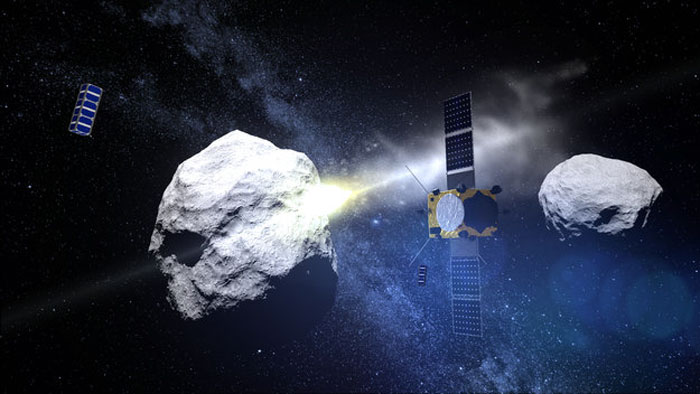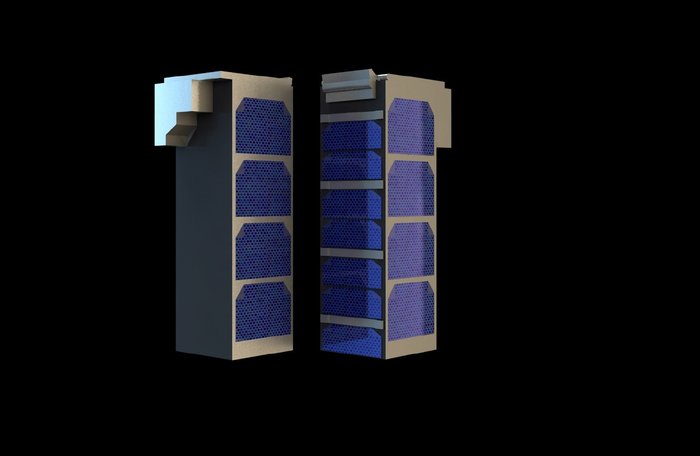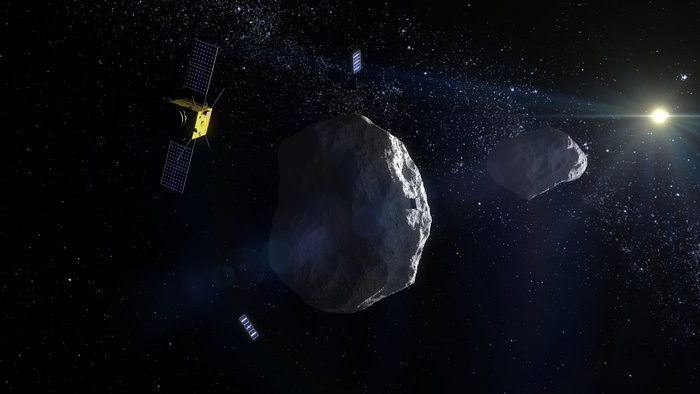.

The five CubeSat concepts to be studied to accompany ESA’s proposed Asteroid Impact Mission into deep space have been selected.
The ideas being looked at include taking a close-up look at the composition of the asteroid surface, measuring the gravity field, assessing the dust and ejecta plumes created during a collision, and landing a CubeSat for seismic monitoring.
The Asteroid Impact Mission, or AIM, undergoing detailed design ahead of a final go/no-go decision by ESA’s Ministerial Council in December 2016, is a deep-space technology-demonstration mission that would also be humanity’s first probe to rendezvous with a double asteroid.
AIM is also set to be Europe’s contribution to a larger international endeavour called the Asteroid Impact & Deflection Assessment (AIDA) mission: the US Double Asteroid Redirection Test (DART) would strike the smaller of the two Didymos asteroids, with AIM on hand for before-and-after monitoring of any resulting orbital and structural shifts.
.

Like a Russian doll, the main AIM spacecraft would carry smaller probes within it: the Mascot-2 lander from the DLR German Aerospace Center, and an additional pair of triple-unit CubeSats.
“CubeSats are nanosatellites based on standardised 10 cm-sized units, which are much cheaper and simpler to build than standard satellites, suitable for higher-risk missions such as envisaged for AIM,” explains Roger Walker, overseeing ESA’s technology CubeSat effort.
“They would in this case be deployed in the vicinity of the asteroid during the DART impact.
“Usually, CubeSats offer an easy means of scientists to launch their experiments into low-Earth orbit. But with AIM we are giving European research teams the chance to design instruments based on the CubeSat standard for deep space, to do specialised scientific work that will complement AIM’s main science goals.
“CubeSat hardware is easy for this community to access and adapt to their needs. It´s like taking inexpensive building kits to do top-notch science.”
“We put out a call for ideas for these CubeSat Opportunity Payloads through the SysNova initiative of ESA’s General Studies Programme,” says Andrés Galvez, Head of the Science Analysis and System Support Unit, which looks at how new instruments could be used in planned space missions.
.

“We put out a call for ideas for these CubeSat Opportunity Payloads through the SysNova initiative of ESA’s General Studies Programme,” says Andrés Galvez, Head of the Science Analysis and System Support Unit, which looks at how new instruments could be used in planned space missions.

“Through SysNova we set technology challenges to get competing concepts we can then assess in detail ahead of making a final choice.
“There were a large number of proposals to the call and teams variously put forward concepts involving either one or two triple-unit CubeSats. We were very pleased by the response and the diversity of scientific missions put forward with such small satellites.”
The selected proposals will now be funded by ESA for detailed study, ahead of a final selection to fill the two berths in June next year.
.

AIM networking with CubeSats
Quelle: ESA
3801 Views

